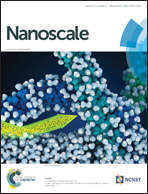A broadening temperature sensitivity range with a core–shell YbEr@YbNd double ratiometric optical nanothermometer†
Abstract
The chemical architecture of lanthanide doped core–shell up-converting nanoparticles can be engineered to purposely design the properties of luminescent nanomaterials, which are typically inaccessible to their homogeneous counterparts. Such an approach allowed to shift the up-conversion excitation wavelength from ∼980 to the more relevant ∼808 nm or enable Tb or Eu up-conversion emission, which was previously impossible to obtain or inefficient. Here, we address the issue of limited temperature sensitivity range of optical lanthanide based nano-thermometers. By covering Yb–Er co-doped core nanoparticles with the Yb–Nd co-doped shell, we have intentionally combined temperature dependent Er up-conversion together with temperature dependent Nd → Yb energy transfer, and thus have expanded the temperature response range ΔT of a single nanoparticle based optical nano-thermometer under single ∼808 nm wavelength photo-excitation from around ΔT = 150 K to over ΔT = 300 K (150–450 K). Such engineered nanocrystals are suitable for remote optical temperature measurements in technology and biotechnology at the sub-micron scale.



 Please wait while we load your content...
Please wait while we load your content...